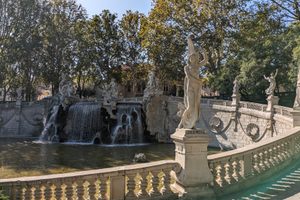
Located on the southern end of Turin’s Valentino Park, the Fontana dei Dodici Mesi (Fountain of the Twelve Months) is a monument sure to catch the eye of anyone interested in architecture, art, and mythology. Two water jets spring from a decorated basin fed by a waterfall. Surrounding the basin are 12 statues of graceful female figures that personify each month of the year.
The personalities of each month shine through, especially in how they interact with the elements of the season. Poor January huddles tightly in her shawl to shield herself from the winter cold, while June can’t seem to wait to shed her layers for the warm summer air. Local geography also plays a role in the fountain’s symbolism. The waterfall feeding the basin is flanked by personifications of the four great rivers of Piedmont: Po, Dora, Stura, and Sangone.
Even the site of the fountain itself is surrounded in legend. It is claimed that Phaethon, son of Helios, fell from the sky onto this spot after getting struck by a lightning bolt from Zeus. A more plausible (but also unproven) story is that this is the place where the Romans founded Augusta Taurinorum, which would later become the modern city of Turin.
The fountain was built for the Italian General Exhibition of 1898, which commemorated the 50th anniversary of the Statuto Albertino, a document that later became the Italian Constitution. The exhibition featured painters, architects, sculptors, and other artists from across Italy. Turinese architect Carlo Ceppi led the design of the Fontana, accompanied by several sculptors.
The fountain was originally set in a pavilion in front of one of the exhibition buildings. Its Rococo and Art Nouveau style was an interesting contrast to the Moorish facade of the building, providing a sharp demonstration of Italy’s architectural range. While most of the buildings and public art for the exhibition were removed, the Fontana dei Dodici Mesi was preserved. Even today, in a park brimming with sculptures and monuments, this fountain remains one of the most captivating features of Parco del Valentino.

Post a Comment